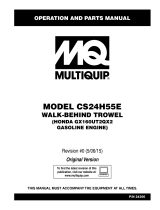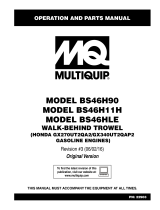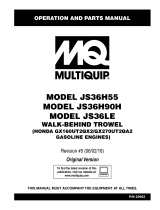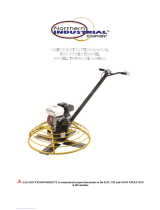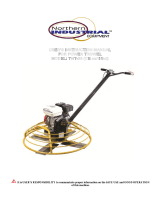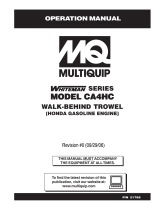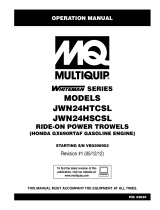
HDA SERIES WALK-BEHIND TROWEL • OPERATION MANUAL — REV. #2 (05/05/20) — PAGE 15
GENERAL INFORMATION
INTENDED USE
Operate this trowel and all associated tools and components
in accordance with the manufacturer's instructions. Use of
any other tools for stated operation is considered contrary
to designated use. The risk of such use lies entirely with the
user. The manufacturer cannot be held liable for damages
as a result of misuse.
TROWEL FAMILIARIZATION
The HDA Series walk-behind trowel is designed for the
floating and finishing of concrete slabs.
Safety instructions are found on the trowel and throughout
this manual. Read all safety instructions carefully.
Maintain all safety information in legible condition.
Operators should be well trained on operation and
maintenance of the unit.
Walk around the trowel and observe all of the major
components (Figure 3)—engine, blades, handle (standard
or Quick Pitch™), air cleaner, centrifugal stop switch, etc.
Make sure there is always oil in the engine.
Before operating the trowel, test it on a flat, watered-down
section of finished concrete that is free of debris and other
objects. This test run will familiarize you with the trowel’s
controls and increase your confidence in using the trowel.
You will learn how the trowel handles under actual operating
conditions.
Engine
The trowel is powered by an 11-hp or 13-hp gasoline
engine. Refer to the engine owner’s manual for engine
operation and maintenance instructions. If the original
manual becomes lost or damaged, please contact your
nearest Multiquip dealer for a replacement.
Continuously Variable Transmission (CVT)
The trowel is equipped with a continuously variable
transmission (CVT) to obtain maximum drive torque. Power
is transferred from the engine to the gearbox input shaft
via a V-belt, or pulley drive, system. The pulley is engaged
by a centrifugal clutch.
Gearbox
Located beneath the engine, the gearbox transfers power
to the rotor and governs the rotational speed of the trowel.
It is equipped with two shafts (input and output).
Blades
The trowel blades finish concrete as they rotate around
its surface. Blades are classified as combination
(8 inches wide), float (8 or 10 inches wide), or finish
(6 inches wide). The trowel is equipped with four blades,
equally spaced in a radial pattern, attached to the vertical
rotating shaft by means of a spider assembly.
Spider
The vertical output shaft of the gearbox connects to a cast
hub called the spider. The spider assembly has four arms
that extend outward, to which the trowel blades or other
accessories attach. As the gearbox output shaft rotates,
so does the spider assembly.
Guard Ring
The trowel is equipped with a safety guard ring which
prevents objects from making contact with the rotating
blades during operation.
Centrifugal Safety Stop Switch
The trowel is equipped with a centrifugal safety stop
switch, which will stop the engine and bring the trowel to a
halt in the event of a runaway trowel condition (the operator
releases the handle).
TRAINING
For proper training, please use the “Training Checklist”
located in the front of this manual. This checklist provides
an outline for an experienced operator to provide training
to a new operator.




















